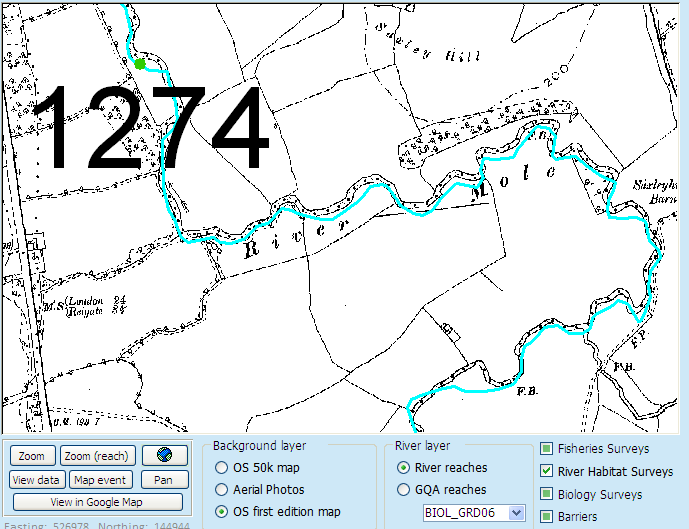Habitat assessment tool
The habitat assessment tool is based on combined RHS, water quality and land use data. It uses conceptual models derived by experts (see 'knowledge resources') and turns them into predictive models using available data.
Expert fisheries officers from the Environment Agency were gathered to build simple conceptual models of fish habitat for 3 life stages (spawning, juveniles and adults). The models were combined and tested on existing fish and habitat data on a total of 2500 sites. The resulting models were then applied to all existing RHS sites and are presented in ToolHab in a graphical way for three species: Trout, Pike and Dace (more species will be added in the future). You can move from one fish model to the other by using the drop down box below the photos (see below).
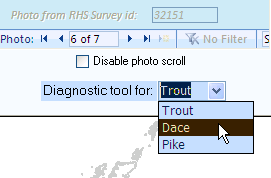
The factors affecting each species habitat can be split into 2 broad groups:
- Natural habitat features;
- Pressures and impacts.
On the figure below, all pressures and natural habitat feature have been grouped into 2 columns.
The figure is 'read' from left to right using colour-coded boxes and lines.
The potential impact of each pressure is indicated using the colour of its box. The colour code is as follow:
- Blue: the pressure may not be present or if it is, it has little or no impact on fish density.
- Yellow: the observed pressure level has a fair amount of impact on fish density
- Orange: the observed pressure level has high impact on fish density
- Red: the observed pressure level has very high impact on fish density.
The suitability of each habitat feature is assessed using the colour of its box. The colour code is as follow:
- Blue: very high
- Green: high
- Yellow: fair
- Orange: poor
- Red: very poor or feature absent.
The coloured lined represent the impact of habitat features and pressures on each other and on fish.
The colour of the lines indicates the nature of the impact:
- blue is for positive impact (e.g. coarse substrate impacts positively on the presence of unbroken waves);
- orange is for negative impact (e.g. tilled land-use will impact negatively on substrate coarseness - by increasing the amount of fine sediment present).
The thickness of the coloured line represents the magnitude of impacts.
Sometimes a pressure can be a positive driver to species distribution. For example, high levels of nutrient enrichment may be detrimental to salmonid species but favour the presence of more pollution tolerant species such as roach or pike. When a pressure is positively associated with the occurrence of a species, it will be displayed in shades of grey (according to its overall level of occurrence) in between the 2 columns representing pressures and natural habitats to highlight its ambivalent role.
When a pressure box colour is cyan and there are no arrows linking it to other boxes, it means that the pressure is absent. When a pressure box is greyed out, it indicates missing data.
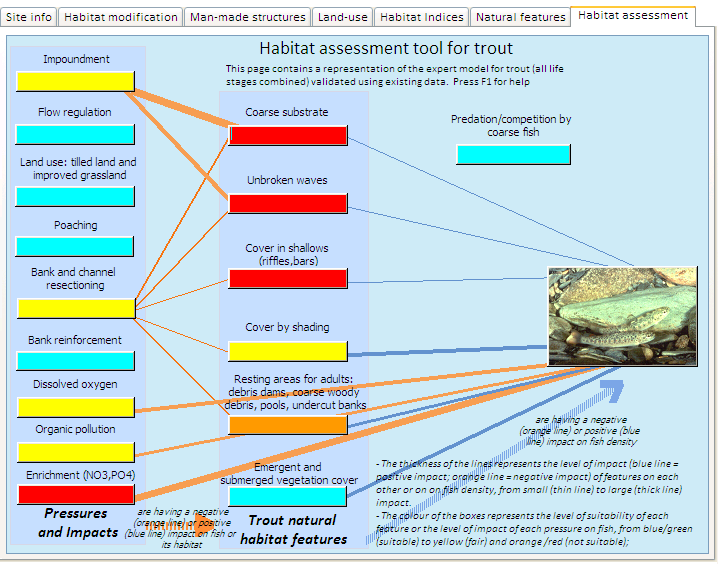
Example:
Trout model
The figure above suggests that the habitats of the river reach are not favourable to trout.
Natural habitat features normally associated with trout are either favourable or fair (cover by shading, channel vegetation) or not favourable (channel substrate, flow type, cover in shallows and resting areas for adults).
The model suggests that the level of pressures on habitats are having an overall moderate to high impact on trout (red and yellow boxes) and a moderate impact on associated natural features. The highest and probably most significant impact according to the model is water quality (enrichment). The levels of phosphates and nitrates are very high and are likely to influence trout populations through their impacts on algal growth and dissolved oxygen. The presence of impoundments is also perceived as having a moderate to high impact. Bank and channel resectioning impact is moderate but it is probably under-estimated. It is likely that bank and channel resectioning are having a significant impact on trout habitats.
This assumes, however, that trout would naturally occur on the reach. The assessment using the fish population and Fisheries Classification Scheme (FCS) tools is that the likelihood of finding trout on such reach at reference condition is 52% but none were caught (see below). The FCS also suggests that, despite the observable modifications and potential impacts on natural habitat features, the fish populations are close to reference condition. The reach is dominated by coarse fish species and especially roach, gudgeon, dace and pike which all have greater than expected densities. Looking at fisheries survey records from the 1980s onward (see River historical account) and information from the river mole wikipedia page in the river historical module, it seems that the reach was always dominated by coarse fish populations and trout may have been present in tributaries such as Gatwick stream. The FCS predictions for trout for Gatwick stream show high levels of natural occurrence for trout so it is possible that trout may have inhabited the Mole around the confluence with Gatwick stream.
We will now consider the habitat models for pike and dace for the reach.
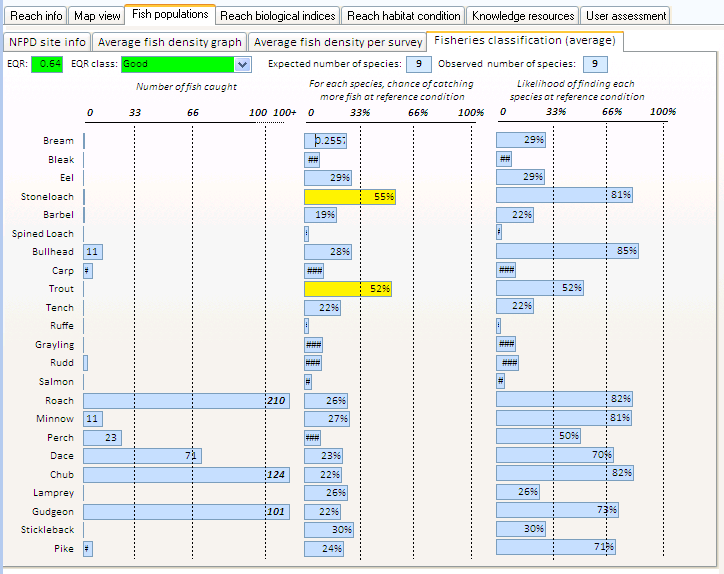
Pike model
The model below suggest that the habitat for pike is very suitable with adequate levels of fine substrate, smooth flows, suitable levels of marginal habitats and plenty of prey (roach, dace, minnows etc.). The model suggest that existing anthropogenic alterations such as impoundment, land use and resectioning could be beneficial to pike habitat as they create the slow flowing conditions and marginal habitats that are favourable to pike. Enrichment could also be beneficial to fish occurrence due to its impact on potential prey density.
Pike are very resistant to pollution and anthropogenic impacts such as resectioning. In fact, only high levels of organic pollution seem to affect their distribution and they seem to favour rivers with moderate to high levels of enrichment (present on this site). Most other types of modifications seem to have potential positive impact on pike habitats. Resectioning, tilled land use and poaching promote the input of fine sediments, smooth flows and marginal vegetation that pike favour.
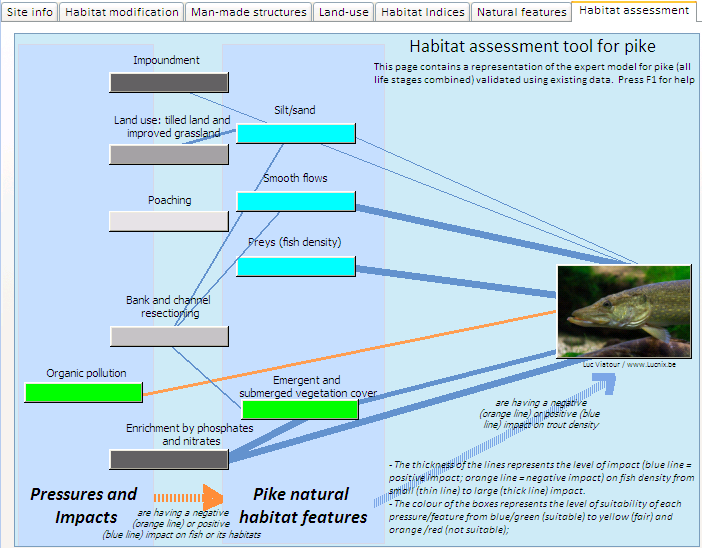
Dace model
The model for dace indicates that the site displays good levels of habitat suitability for dace apart from substrate which was altogether too fine. Most natural habitat feature indicators show high levels of suitability and pressures such as bank and channel resectioning and dissolved oxygen are at tolerable ('fair') levels and do not seem to affect negatively dace habitat structure. Dace tend to favour habitat with moderate levels of enrichment. Enrichment on site could have a positive impact on dace occurrence. Bank and channel resectioning does not seem to affect dace as much as trout. This is potentially due to the fact that although dace requires coarse substrate to reproduce, it is more tolerant to fine sediment inputs and it does not require fast flowing features such as trout. On the contrary, dace tends to be associated with sites dominated by deeper mesohabitats such as runs and glides and structures or modifications such as weirs and resectioning increasing depth may be beneficial to them.
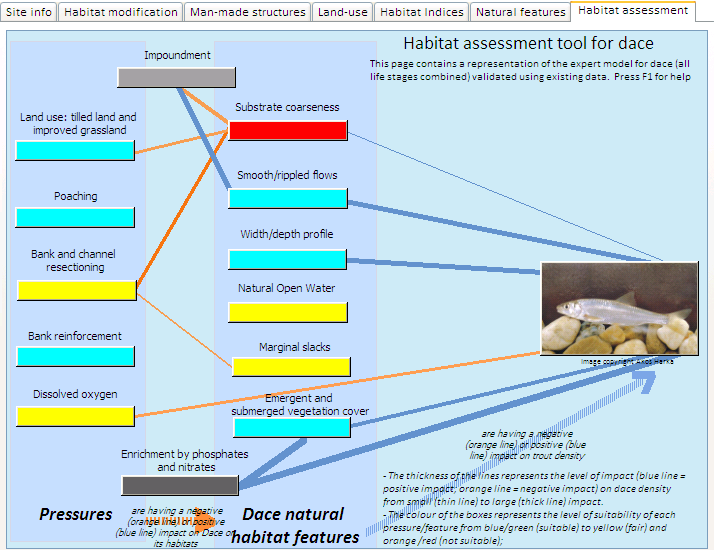
In summary, we see here how the fish conceptual and predictive models can be used in combination with fish, chemistry, RHS and other data to diagnose potential pressures and impacts on species habitats at reach scale.
The fisheries predictive models indicated a potential lack of trout and a potential higher than expected dace and pike population. The conceptual expert models suggested that channel resectioning, impoundment, land use and water quality may explain the absence of habitat features naturally associated with trout and the occurrence of features associated with pike and dace.
Further investigations into historical records may be required to ascertain the true nature of original fish populations.
We may want, for example to look at historical maps to see how the river has changed since the 1900s. You can turn the background layer on and off by clicking the 'Show background layer' button.
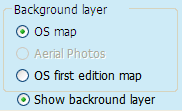
Below is a snapshot of the 1897 OS maps around RHS site 1274, just downstream of Gatwick airport. As can be seen, the river has not changed its course much since the beginning of the 20th century. This suggest that the modifications observed either pre-date the 20th century or they have been carried out without modifying the planform of the river (i.e. without realigning it).
